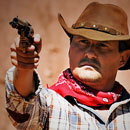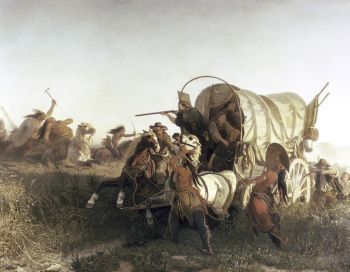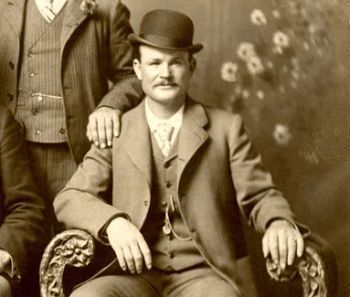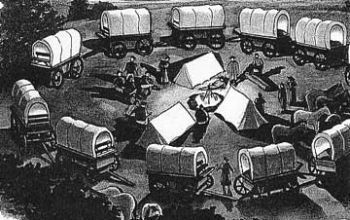5 Ridiculous Myths Everyone Believes About the Wild West

The Wild West, aka the Old West, was an astoundingly awesome period in American history that every person who has ever played Red Dead Redemption wants to emulate. Now, clearly pop culture has turned much of the true West into bullshit legend -- there were never quick-draw artists who could shoot a six gun out of your hand with another six gun. But the basics were true, right? The lawlessness, the guns, the constant Indian attacks?
Well ... not exactly. Some common myths you probably still believe include ...
Settlers Were Constantly Clashing With Indians

The Myth:
Old Westerns treat Native Americans kind of like The Walking Dead treats zombies -- sudden, murderous ambushes could come from anywhere, at any time. Any expedition into "injun" territory came with the warning that you'd better go well-armed. When wagon trains saw a raid of Cherokee or Sioux coming, they would "circle the wagons" to form a defense perimeter -- and to this day, "circle the wagons" is shorthand for "hunker down and fight back."
And all of this has to be true; we know that horrific numbers of people died when settlers expanded West. Those frontiersmen must have been firing bullets and dodging arrows on a daily basis, right?
The Reality:
Well, not really. Granted, between the United States cavalry and, uh, pretty much every tribe you can name, things certainly got good and massacre-y. But skirmishes between Native Americans and the typical American settler trundling along in his covered wagon hardly ever happened. Of the hundreds of thousands of pioneers who willingly trudged all the way through Nebraska, only a few hundred died in clashes with Native Americans.

We repeat: not tens of thousands, not even thousands. About 300 to 400. To put that number in perspective, the total number of pioneer deaths on the Oregon Trail from all causes (including disease) numbered 10,000 to 30,000, which means only 1 to 4 percent of all trail fatalities can be attributed to Native Americans. Hell, we bet more settlers were accidentally trampled by their own cows.

During this same period, settlers killed over 400 Native Americans. Again, that's not zero, but it does mean that the vast majority of settlers never got into a murderous conflict with hostile tribes. It was far more likely that the average settler would trade with Native Americans or hire members of various tribes as guides, rather than fight them. It wasn't necessarily because they were open-minded and peace loving that they abstained from violence, but rather that it's never good business to kill your customers, or vice versa. Especially when you're talking about someone providing a potentially life-saving service (a guide kept you from getting lost, when getting lost meant getting dead).
Native American deaths caused by the U.S. government and the military likely number in the millions. No one's disputing that one. But deaths due to wagon train clashes were few and far between. As for the "circling the wagons" thing, that ring formation was done each night not to keep hostile Indians out, but to keep their absurdly expensive cattle from wandering off. Hell, it wouldn't even be possible to "circle the wagons" in an emergency -- these wagon trains typically traveled spread out in a line several miles wide, rather than in the column that the term "train" suggests, in an effort to avoid each other's dust, wheel ruts, and debris. It would have taken hours to get everybody together and hooked up in circle formation.

Bank-Robbing Outlaws Ruled the West

The Myth:
Black Bart, the Dalton Gang, and Butch Cassidy and the Sundance Kid all were famous for their daring robberies. They could take entire fortunes from banks that had slightly less security than a modern hot dog stand.

And why not? Lawlessness ruled, vaults didn't exist, and criminals didn't give a shit. The banks might as well have left their big white bags of gold sitting out on the porch.
The Reality:
Research can find evidence of only about eight true bank heists, and that's across 15 states in 40 freaking years. Eight. As a point of comparison, bank robberies in 2010 amounted to 5,600. Hell, even if we'd never seen a Western in our lives, that would seem like a low number.

But there are several things to consider. First, towns back in those days were much smaller, with the sheriff's office, saloon, general store, and bank usually clustered together for convenience. This one-stop social-needs block usually made up the dead center of town. Being that the sheriff's office was usually no more than a few doors down, you were probably pulling your big heist within earshot of the law.

Second, the banks actually weren't that easy to get in and out of. Old West buildings were usually built pretty close together, meaning the bank would be flanked by other buildings, while a reinforced back wall would keep anyone from intruding from behind (you can sort through the Freudian implications of that). When you walk out the front door with the loot, there's the sheriff waiting for you. Now, the most famous robberies -- the jobs pulled by Butch Cassidy and the Sundance Kid -- were actually true. But that's the point -- they got famous for a reason. They were doing what nobody else was crazy enough to do.
But for everyday criminals, common targets were often trains and stagecoaches because they were more isolated, easier to get into, and easier to escape. So why bother with a bank, which would be a suicide mission in comparison?

Cowboys Are an American Creation

The Myth:
One reason Americans have always been so in love with the Old West is that it's so distinctly American. Today, if you find a political rally of people proclaiming themselves to be patriots, you can damn well bet you'll find cowboy hats in that crowd. The more of a cowboy you are, the more American you are. Even Cracked favorite Teddy Roosevelt got in on the act by calling himself the "cowboy candidate."
The Reality:
Cowboys weren't an American invention at all. In fact, they precede Plymouth Rock by some 20 years, meaning they're older than America itself. The original cowboys were Mexican cattlemen known as vaqueros, and they are literally everything you imagine a cowboy to be.

They came up with all of the cowboy lingo, including "bronco," "lariat," and even "stampede." Vaqueros rode the long-haul cattle drives, and their sombreros were probably the precursor to cowboy hats. They also wore chaps, held rodeos, and lived the life of a cowboy in relative anonymity for some 200 years.
When Americans moved westward, it was these vaqueros who knew the land and wildlife enough to help teach the future American cowboys everything they knew. The settlers in turn did the right thing and outright stole the entire culture, including the title of "vaqueros," which was turned into "buckaroos."

"The only thing those gringos can't steal is my beard."
But it's not like vaqueros went the way of the cowboy at the time, either. Despite what Hollywood would have you believe, not every cowboy (or human being, for that matter) was a white male. One in three cowboys were Mexican vaquero. One in four are believed to be black men who were released from slavery but didn't have the ability to flee far from their captors. Even the Native Americans would help move the cattle with their white, Mexican, and black brethren. It was a rainbow cowboy coalition! Except if you were Chinese. Then you were building railroads in hellish conditions.
Cowboys Wore Cowboy Hats

The Myth:
The ultimate item of the cowboy outfit is of course the Stetson hat, which most of us just call a cowboy hat. There's always the boots, too, but they kind of go together as a pair.

We're not entirely sure why the Texas license plate is there.
The hats were practical, lightweight, and made with utility in mind. They had curved edges that could defend you from both sun and rain, and they made you look incredibly stylish while doing what amounted to staring at cows for weeks at a time. The curved brim, those dips in the crown, the band -- the Stetson is about as iconic as clothing gets. So if you get in your time machine and set it for 1870, you'd damn well better be packing one of these:
The Reality:
Lots of people wore hats back then, that part's true. But they seemed to wear everything but what we think of as "cowboy" hats. Here's Billy the Kid wearing some kind of fucked-up top hat:

Here, enjoy this theme music.
Here's Wild Bill Hickok wearing a woman's flat pancake hat:

But what you would have seen mostly back then were bowler hats:

"My, my, chap, shall we go forth for some train robberies?"
They were more popular because they were a little more versatile in various social situations, especially in a time when all men wore hats all the damn time. In fact, famed Western historian Lucius "Clearly a Fake Name" Beebe went so far as to call it "the hat that won the West." Looking back on most portraits from the time, you can find that almost every single major name in the West owned a bowler hat, at least if they had class.

Even the cowboy hats that Stetson was making in the late 1800s didn't look like the Stetson hats we call "cowboy hats" today. Originally known as "the Boss of the Plains," it looked more like modern Amish hats, and may have been just a modified sombrero.
All of the curling and ornamentation came later, but this hat is the granddaddy of every cowboy hat in the world today. And that's not exactly what your mind jumps to when you think of cowboy hats, is it?
Guns Were Rampant in the Old West

The Myth:
Well, even if cowboys didn't have cowboy hats, we sure as hell know they had six-shooters on their hip. Back then, every man, woman, and child came pre-equipped with an old-timey revolver, which was used for everything from personal defense and hunting to celebrating.

The Reality:
Regardless of the public's perception, gun control laws may have actually been stricter back in the 19th and early 20th century than they are now, especially in the West. In the beginning, there was definitely gun violence, as there was neither standardized law nor a good way to enforce it, but the Wild West didn't stay wild forever.
As towns formed and communities grew, the need for and tolerance of handguns started to fall. Starting in 1878, some 25 years into the westward expansion, action was finally taken -- even places as wild as Dodge City started posting signs like this:
In fact, the gunfight at the O.K. Corral was caused by one gang being unwilling to abide by the anti-firearm rule of Tombstone.
But it's not like the six-shooter of the time was very dangerous anyway. They didn't even use regular bullets like they currently do, instead opting for the so-called "cap-and-ball" system that was little more than a marble launched by black powder. It had an effective range of maybe 50 feet. The Adams, one of the first revolvers introduced at the time and a hallmark weapon of the era, would burn the living hell out of your hand while launching the bullet. So you had to be really sure you wanted to shoot that dude.

That's why, even among those who used guns, six-shooters weren't the favorite. They were little more than a weapon of last resort. Shotguns and rifles were the preferred weapons, having both the power and the range to put down a mountain lion or a card-cheating son of a bitch. But who would ever want to watch a Western where cowboys were meeting at high noon to shoot each other in the face with huge shotguns?
Well, actually ...
For more ridiculous myths you believe, check out 6 Things From History Everyone Pictures Incorrectly. Or discover The 5 Most Overrated Jobs Of All-Time.
If you're pressed for time and just looking for a quick fix, then check out 4 Reasons Everyone in the New Superman Movie is a Dick.
And stop by LinkSTORM to discover why you should always be ready to save a lady from the train tracks.
Do you have an idea in mind that would make a great article? Then sign up RIGHT NOW and pitch your first article today! Do you possess expert skills in image creation and manipulation? Mediocre? Even rudimentary? Are you frightened by MS Paint and simply have a funny idea? You can create an infographic and you could be on the front page of Cracked.com tomorrow!
And don't forget to follow us on Facebook, Twitter, and Tumblr to get sexy, sexy jokes sent straight to your news feed. Are you on Google+? So are we!
We have some bad news: the U.S. was never the "underdog" we think we were, everything you know about ancient Egypt is Hollywood nonsense and your favorite book sellers are now taking pre-orders for a text book written and illustrated entirely by the Cracked team! Hitting shelves in October, Cracked's De-Textbook is a fully-illustrated, systematic deconstruction of all of the bullshit you learned in school.

It's loaded with facts about history, your body, and the world around you that your teachers didn't want you to know. And as a bonus? We've also included the kinkiest sex acts ever described in the Bible.




